Barge
Barge often refers to a flat-bottomed inland waterway vessel which does not have its own means of mechanical propulsion.[2] The first modern barges were pulled by tugs, but on inland waterways, most are pushed by pusher boats, or other vessels. The term barge has a rich history, and therefore there are many other types of barges.


History of the barge
Etymology
"Barge" is attested from 1300, from Old French barge, from Vulgar Latin barga. The word originally could refer to any small boat; the modern meaning arose around 1480. Bark "small ship" is attested from 1420, from Old French barque, from Vulgar Latin barca (400 AD). The more precise meaning of Barque as "three-masted sailing vessel" arose in the 17th century, and often takes the French spelling for disambiguation. Both are probably derived from the Latin barica, from Greek baris "Egyptian boat", from Coptic bari "small boat", hieroglyphic Egyptian
and similar ba-y-r for "basket-shaped boat".[3] By extension, the term "embark" literally means to board the kind of boat called a "barque".
The British river barge


In Great Britain a merchant barge was originally a flat bottomed merchant vessel for use on navigable rivers.[4] Most of these barges had sails. For traffic on the River Severn the barge was described as: The lesser sort are called barges and frigates, being from forty to sixty feet in length, having a single mast and square sail, and carrying from twenty to forty tons burthen. The larger vessels were called trows.[5] On the River Irwell there was reference to barges passing below Barton Aqueduct with their mast and sails standing.[6] Barges on the Thames were called west country barges.[4]
British canals: narrowboats and widebeams
During the Industrial Revolution, a substantial network of narrow canals was developed in Great Britain from 1750 onward. These new British canals had locks of only 7 feet (2.1 m) wide. This led to the development of the narrowboats, which had a beam of no more than 6 feet 10 inches (2.08 m). It was soon realized that the narrow locks were too limiting. Later locks were therefore doubled in width to 14 feet (4.3 m). This led to the development of the widebeam.
The narrowboats were initially also known as barges, but only a very few had sails, unlike earlier vessels. From the start, most of the new canals were constructed with an adjacent towpath along which draft horses walked, towing the barges. These types of canal craft are so specific that on the British canal system the term 'barge' was not used to describe narrowboats and widebeams. Narrowboats and widebeams are still used on canals, now engine-powered.
The Thames barge and Dutch barge
On the British canal system, the Thames sailing barge, and Dutch barge and unspecified other styles of barge, are still known as barges.[7] The term Dutch barge is nowadays often used to refer to an accommodation ship, but originally refers to the slightly larger Dutch version of the Thames sailing barge.
Crew and pole
The people who moved barges were known as lightermen. Poles are used on barges to fend off other nearby vessels or a wharf. These are often called 'pike poles'. The long pole used to maneuver or propel a barge has given rise to the saying "I wouldn't touch that [subject/thing] with a barge pole."[8]
The 19th century British barge

In the United Kingdom the word barge had many meanings by the 1890s, and these varied locally. On the Mersey a barge was called a 'Flat', on the Thames a Lighter or barge, and on the Humber a 'Keel'.[9] A Lighter had neither mast nor rigging.[10] A keel did have a single mast with sails.[9] Barge and lighter were used indiscriminately. A local distinction was that any flat that was not propelled by steam was a barge, although it might be a sailing flat.[9]
The term Dumb barge was probably taken into use to end the confusion. The term Dumb barge surfaced in the early nineteenth century. It first denoted the use of a barge as a mooring platform in a fixed place. As it went up and down with the tides, it made a very convenient mooring place for steam vessels.[11] Within a few decades, the term dumb barge evolved, and came to mean: 'a vessel propelled by oars only'.[12] By the 1890s Dumb barge was still used only on the Thames.[13]
By 1880 barges on British rivers and canals were often towed by steam tugboats.[14] On the Thames, many dumb barges still relied on their poles, oars and the tide. Others dumb barges made use of about 50 tugboats to tow them to their destinations. While many coal barges were towed, many dumb barges that handled single parcels were not.[15]
The 19th century American barge
In the United States a barge was not a sailing vessel by the end of the 19th century. Indeed, barges were often created by cutting down (razeeing) sailing vessels. In New York this was an accepted meaning of the term barge. The somewhat smaller scow was built as such, but the scow also had its sailing counterpart the sailing scow.
The modern barge
The iron barge
The innovation that led to the modern barge was the use of iron barges towed by a steam tugboat. These were first used to transport grain and other bulk products. From about 1840 to 1870 the towed iron barge was quickly introduced on the Rhine, Danube, Don, Dniester, and rivers in Egypt, India and Australia. Many of these barges were built in Great Britain.[17]
Nowadays 'barge' generally refers to a dumb barge.[18] In Europe, a Dumb barge is: An inland waterway transport freight vessel designed to be towed which does not have its own means of mechanical propulsion.[2] In America, a barge is generally pushed.
Modern use

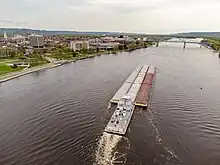
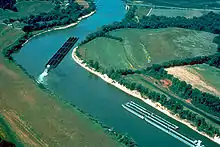

Barges are used today for transporting low-value bulk items, as the cost of hauling goods that way is very low. Barges are also used for very heavy or bulky items; a typical American barge measures 195 by 35 feet (59.4 m × 10.7 m), and can carry up to about 1,500 short tons (1,400 t) of cargo. The most common European barges measure 251 by 37 feet (76.5 m × 11.4 m) and can carry up to about 2,450 tonnes (2,700 short tons).
As an example, on June 26, 2006, in the US a 565-short-ton (513 t) catalytic cracking unit reactor was shipped by barge from the Tulsa Port of Catoosa in Oklahoma to a refinery in Pascagoula, Mississippi. Extremely large objects are normally shipped in sections and assembled after delivery, but shipping an assembled unit reduces costs and avoids reliance on construction labor at the delivery site, which in the case of the reactor was still recovering from Hurricane Katrina. Of the reactor's 700-mile (1,100 km) journey, only about 40 miles (64 km) were traveled overland, from the final port to the refinery.
Self-propelled barges may be used for traveling downstream or upstream in placid waters; they are operated as an unpowered barge, with the assistance of a tugboat, when traveling upstream in faster waters. Canal barges are usually made for the particular canal in which they will operate.
Unpowered vessels—barges—may be used for other purposes, such as large accommodation vessels, towed to where they are needed and stationed there as long as necessary. An example is the Bibby Stockholm.[19]
Types
- Admiral's barge
- Articulated tug and barge – Boat that maneuvers other vessels by pushing or towing them
- Barracks barge – Watercraft serving as floating personnel accommodation ("accommodation barge")
- Bin barge
- Canal motorship – The last self-propelled regularly scheduled commercial ship on the Erie canal.
- Car float – Unpowered barge with railroad tracks mounted on its deck
- Ferrocement or "Concrete" Barge
- Crane barge – Ship with a crane specialized for lifting heavy loads
- Dredges – Excavation of sediment, usually under water
- Deck barge
- Dutch barge – Flat-bottomed shoal-draught sailing barge
- Dry bulk cargo barge – Vessel designed to carry freight in bulk format
- Gundalow – Type of New England sailing barge
- Hopper barge – non-mechanical ship or vessel that cannot move around by itself
- Hotel barge
- Horse-drawn boat – Canal boat a canal pulled by a horse on a towpath
- Jackup barge – Type of mobile platform
- Landing craft – Seagoing watercraft
- Lighter – Type of flat-bottomed barge
- Liquid cargo barge – barge that transports petrochemicals
- Log barge
- Notch barge
- Narrowboat – Type of British canal boat
- Norfolk wherry – type of boat on The Broads in Norfolk, England
- Rocket landing barge – Floating landing platform operated by SpaceX
- Oil barge
- Paddle barge – Water sport
- Péniche – type of ship or Spitz barge
- Pleasure barge – Flat-bottomed, slow-moving boat used for leisure
- Power barge – Floating power station
- Row barge
- Royal barge
- Sand barge
- Severn trow – Type of British river cargo boat
- Spud barge
- Tank barge
- Thames sailing barge – Type of commercial sailing boat
- Tub boat – Canal cargo boat
- Vehicular barge
- Whaleback barge – Type of cargo steamship
- Widebeam – Canal boat in the style of a British narrowboat with a wider beam
- Feed Barge
Image gallery
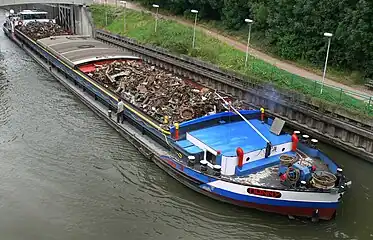 A self propelled barge carrying recycling material on Deûle channel in Lambersart, France
A self propelled barge carrying recycling material on Deûle channel in Lambersart, France Self-propelled car barge on the River Danube
Self-propelled car barge on the River Danube Barges near Toulouse, France
Barges near Toulouse, France_Hannover_Mittellandkanal_2006_by-RaBoe.jpg.webp) Self-propelled barge Andromeda in canal at Hanover, Germany
Self-propelled barge Andromeda in canal at Hanover, Germany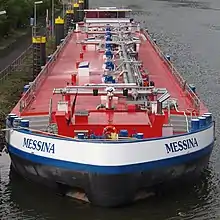 Tank barge on the River Moselle, Germany
Tank barge on the River Moselle, Germany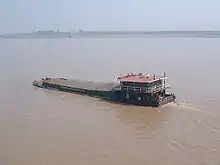 Self-propelled barge carrying bulk crushed stone
Self-propelled barge carrying bulk crushed stone Self-propelled barge in the port of IJmuiden, Netherlands
Self-propelled barge in the port of IJmuiden, Netherlands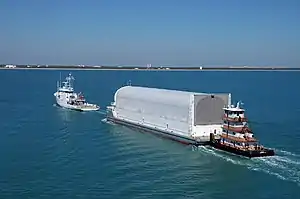 Deck barge[1] carrying the Space Shuttle external tank for STS-119 under tow to Port Canaveral, Florida, United States
Deck barge[1] carrying the Space Shuttle external tank for STS-119 under tow to Port Canaveral, Florida, United States

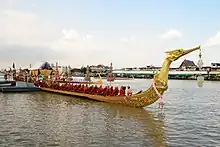 Royal Barge Suphannahong docked at Wat Arun pier, one of the Thai royal barges featured in the royal barge ceremony
Royal Barge Suphannahong docked at Wat Arun pier, one of the Thai royal barges featured in the royal barge ceremony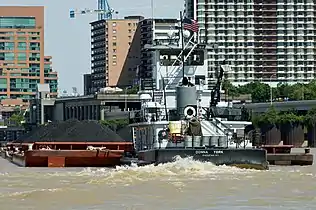
_-_Volga_Boatmen_(1870-1873).jpg.webp) Barge Haulers on the Volga (1870–73), by Ilya Repin
Barge Haulers on the Volga (1870–73), by Ilya Repin Tongkang or car barge, landed on Ketapang Port, Banyuwangi, Indonesia
Tongkang or car barge, landed on Ketapang Port, Banyuwangi, Indonesia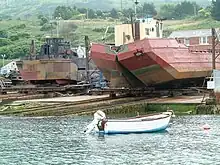
.jpg.webp)
 US Navy Water Type B ship Barge, YW-59, launched August 29, 1941
US Navy Water Type B ship Barge, YW-59, launched August 29, 1941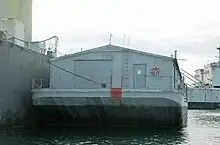 YFN-958 a covered lighter barge, non-Self-propelled. Built by Mare Island Navy Shipyard in 1944.
YFN-958 a covered lighter barge, non-Self-propelled. Built by Mare Island Navy Shipyard in 1944. Ferrocement Barge, US-102, in the Erie Canal
Ferrocement Barge, US-102, in the Erie Canal WW2 concrete barge at the National Waterways Museum, Ellesmere Port, Cheshire, UK
WW2 concrete barge at the National Waterways Museum, Ellesmere Port, Cheshire, UK Sun shining into the empty asphalt barge Endeavour while under repair in Muskegon, Michigan.
Sun shining into the empty asphalt barge Endeavour while under repair in Muskegon, Michigan.
 Accommodation Work Barge
Accommodation Work Barge
See also
References
- "All craft great and small", Canal & River Trust, W. Owen, London, 2019, retrieved 21 January 2020
- CESNI (2021), European Standard laying down Technical Requirements for Inland Navigation vessels (PDF), European Committee for drawing up Standards in the field of Inland Navigation (CESNI), archived (PDF) from the original on 2022-10-09
- Commissioner of Navigation (1905), Annual Report of the Commissioner of Navigation, Department of Commerce and Labor
- Dickens, Charles (1880), Dickens's Dictionary of the Thames from Oxford to the Nore, Charles Dickens, London
- "Evolution of the inland barge", Proceedings of the merchant marine council, The Merchant Marine Council of the United States, vol. 15, pp. 140–141, 1958
- Illustrated Glossary for Transport Statistics 4th Edition, Eurostat - ITF - UNECE, 2010, ISBN 9789282102947
- McKellar, M.W.; Hocking, H.H. (1871), "Court of Common Pleas", Reports of the Cases Relating to Maritime Law: Decided by the Admiralty, Horace Cox, London, vol. III
- Phillips, J. (1792), A general history of inland navigation, foreign and domestic, I. and J. Taylor, London
- Redman, John B. (1843), "The terrace pier, Gravesend", Minutes of Proceedings of the Institution of Civil Engineers, Institution of Civil Engineers, London
- Royal Commission on Labour (1893), Index to the Evidence taken before Groups A., B., & C., Her Majesty's Stationery Office
- Seymour, D.C. (1869), Proceedings of the commercial convention held in New Orleands, L. Graham & Co. New Orleans
- A Society of Gentlemen (1763), A New and Complete Dictionary of Arts and Sciences, W. Owen, London
Notes
- Evolution 1958, p. 141.
- Eurostat 2010, p. 77.
- An Egyptian hieroglyphic dictionary: with an index of English words by Sir Ernest Alfred Wallis Budge from Google Books
- A Society of Gentlemen 1763, p. 261.
- Phillips 1792, p. 218.
- Phillips 1792, p. 75.
- Canal & River Trust 2019.
- Randolph Henry Spencer Churchill (1885). H. W. Lucy (ed.). Speeches of Lord Randolph Churchill. G. Routledge. p. 51.
...never was land so easily and cheaply in the grasp of the capitalist as it is now, if he chose to put out his hand, and yet there is not a capitalist in his senses who would touch it with a barge pole.
- Royal Commission on Labour 1893, p. 24.
- Royal Commission on Labour 1893, p. 52.
- Redman 1843, p. 238.
- McKellar & Hocking 1871, p. 391.
- Royal Commission on Labour 1893, p. 39.
- Dickens 1880, p. 15.
- Dickens 1880, p. 17.
- Seymour 1869, p. 90.
- CESNI 2021, p. 1.
- Dresch, Matthew (4 April 2023). "On board 500-room barge Bibby Stockholm asylum seeker 'floatel'". Dorset Live.
External links
- Barge Lehigh Valley 79 at the Waterfront Museum, Brooklyn, New York, United States
- Britain's Official guide to canals, rivers and lakes
- Chisholm, Hugh, ed. (1911). . Encyclopædia Britannica (11th ed.). Cambridge University Press.
- DBA The Barge Association
- The American Waterways Operators